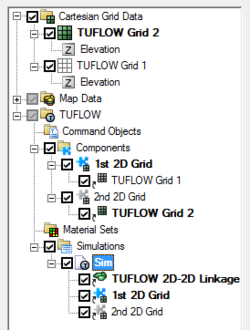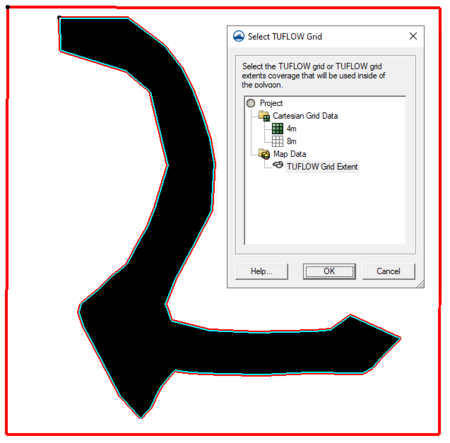SMS:TUFLOW Linking 2D Domains: Difference between revisions
From XMS Wiki
Jump to navigationJump to search
No edit summary |
No edit summary |
||
| (14 intermediate revisions by the same user not shown) | |||
| Line 1: | Line 1: | ||
Any number of grids of varying sizes and/or orientations may be used in TUFLOW. Using multiple 2D domains requires that multiple 2D domains are licensed in TUFLOW. | [[File:TUFLOW-2D-2DLinkSimulation.png|thumb|250 px|Example of linking 2D domains in a TUFLOW simulation]] | ||
Any number of grids of varying sizes and/or orientations may be used in TUFLOW. Using multiple 2D domains requires that multiple 2D domains are licensed in TUFLOW. Contact [https://www.tuflow.com/Default.aspx TUFLOW] to add this feature to the model license. | |||
To setup multiple 2D domains in SMS: | To setup multiple 2D domains in SMS: | ||
# Create multiple TUFLOW grids and associated grid components. | # Create multiple TUFLOW grids and associated grid components. | ||
# Define a 2D/2D Linkage coverage and attributes (see below). | # Define a 2D/2D Linkage coverage and attributes (see below). | ||
# Add all the 2D domains being used and the [[SMS:TUFLOW_Coverages#2D/2D Links Coverage|2D/2D Links | # Add all the 2D domains being used and the [[SMS:TUFLOW_Coverages#2D/2D Links Coverage|2D/2D Links coverage]] to the simulation. | ||
There are a few important items to keep in mind when setting up a 2D/2D Linkage coverage. | There are a few important items to keep in mind when setting up a 2D/2D Linkage coverage. | ||
# | # It's necessary that a polygon is enclosing each domain to be used. In the case below, a polygon is needed that covers the area outside of the main channel polygon. In most cases, multiple polygons will need to be created on the coverage—one for each grid. | ||
# Each polygon needs to be linked to a specific 2D domain. This is done by double clicking on each polygon and specifying the appropriate 2D grid. | # Each polygon needs to be linked to a specific 2D domain. This is done by double-clicking on each polygon and specifying the appropriate 2D grid. | ||
# Set the vertex spacing on the arcs that join multiple 2D domains. The spacing along these arcs determines how flows move between the domains. The rule of thumb to start with is to have the vertex spacing equal to 1.5 times the larger cell size. | # Set the vertex spacing on the arcs that join multiple 2D domains. The spacing along these arcs determines how flows move between the domains. The rule of thumb to start with is to have the vertex spacing equal to 1.5 times the larger cell size. | ||
[[Image:2Dto2DLinkage.png| | [[Image:2Dto2DLinkage.png|450px]] | ||
==Related Topics== | |||
* [[SMS:TUFLOW_Coverages#2D/2D Links Coverage|TUFLOW 2D/2D Links Coverage]] | |||
{{Template:Navbox SMS}} | {{Template:Navbox SMS}} | ||
{{stub}} | |||
[[Category:TUFLOW|Linking 2D Domains]] | [[Category:TUFLOW|Linking 2D Domains]] | ||
[[Category:External Links]] | |||
Latest revision as of 19:06, 8 March 2018
Any number of grids of varying sizes and/or orientations may be used in TUFLOW. Using multiple 2D domains requires that multiple 2D domains are licensed in TUFLOW. Contact TUFLOW to add this feature to the model license.
To setup multiple 2D domains in SMS:
- Create multiple TUFLOW grids and associated grid components.
- Define a 2D/2D Linkage coverage and attributes (see below).
- Add all the 2D domains being used and the 2D/2D Links coverage to the simulation.
There are a few important items to keep in mind when setting up a 2D/2D Linkage coverage.
- It's necessary that a polygon is enclosing each domain to be used. In the case below, a polygon is needed that covers the area outside of the main channel polygon. In most cases, multiple polygons will need to be created on the coverage—one for each grid.
- Each polygon needs to be linked to a specific 2D domain. This is done by double-clicking on each polygon and specifying the appropriate 2D grid.
- Set the vertex spacing on the arcs that join multiple 2D domains. The spacing along these arcs determines how flows move between the domains. The rule of thumb to start with is to have the vertex spacing equal to 1.5 times the larger cell size.
Related Topics
SMS – Surface-water Modeling System | ||
|---|---|---|
| Modules: | 1D Grid • Cartesian Grid • Curvilinear Grid • GIS • Map • Mesh • Particle • Quadtree • Raster • Scatter • UGrid |  |
| General Models: | 3D Structure • FVCOM • Generic • PTM | |
| Coastal Models: | ADCIRC • BOUSS-2D • CGWAVE • CMS-Flow • CMS-Wave • GenCade • STWAVE • WAM | |
| Riverine/Estuarine Models: | AdH • HEC-RAS • HYDRO AS-2D • RMA2 • RMA4 • SRH-2D • TUFLOW • TUFLOW FV | |
| Aquaveo • SMS Tutorials • SMS Workflows | ||

